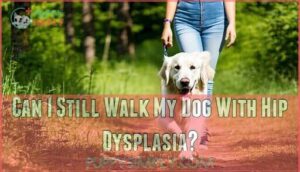This site is supported by our readers. We may earn a commission, at no cost to you, if you purchase through links.

Look for signs like difficulty moving, constant limping, or losing interest in things they once loved—like wagging at the sound of dinner.
If treatment isn’t helping and they’re more miserable than happy, it may be time to let them go peacefully.
Your dog relies on you to choose their comfort over your heartbreak, which isn’t easy, but it’s love in its purest form.
Stay informed and trust your gut; you’ll know when it’s time.
Table Of Contents
- Key Takeaways
- What is Hip Dysplasia in Dogs?
- Can a Dog Live With Hip Dysplasia?
- Treatment Options for Dogs With Hip Dysplasia
- Are There at Home Treatment Options for Hip Dysplasia?
- Are There Exercises for Dogs With Hip Dysplasia?
- Can I Still Walk My Dog With Hip Dysplasia?
- Will Hip Dysplasia Eventually Kill My Dog?
- When Should You Decide to Euthanize?
- Other Factors to Consider When Deciding to Euthanize
- Guidance on Euthanizing a Dog With Hip Dysplasia
- Frequently Asked Questions (FAQs)
- Should I treat my dog’s hip dysplasia?
- Can a dog have hip dysplasia?
- How does hip dysplasia work in dogs?
- Does hip dysplasia shorten a dog’s life?
- How do I know if my dog has hip dysplasia?
- Should a dog be euthanized due to hip dysplasia?
- Will my dog be in pain with hip dysplasia?
- What is stage 4 hip dysplasia in dogs?
- Are there any medications or supplements that can help my dog with hip dysplasia?
- How can I help my dog with hip dysplasia stay comfortable?
- Conclusion
Key Takeaways
- Watch for signs like trouble walking, constant pain, or losing interest in daily activities to assess your dog’s quality of life.
- If medications stop working and mobility declines, talk to your vet about euthanasia as a compassionate option.
- Prioritize your dog’s comfort over emotional difficulty; it’s an act of love when suffering outweighs joy.
- Trust your instincts, and consult your vet to explore every treatment option before making a final decision.
What is Hip Dysplasia in Dogs?
Watching your dog struggle to stand, you’re likely facing the heartbreaking reality of hip dysplasia—a genetic condition affecting joint development where the ball and socket don’t fit properly.
Watching your beloved pet face challenges standing reminds you of their courage amidst the struggles of hip dysplasia.
This painful disorder progresses gradually, causing inflammation and mobility issues. Large breeds like German Shepherds show higher breed susceptibility, though any dog can develop it.
Early symptom recognition includes limping, difficulty climbing stairs, and reluctance to exercise. As the condition progresses, canine hip pain becomes more evident through muscle loss and changed gait.
Understanding this joint development issue is your first step toward helping your furry friend navigate this challenge. A supportive brace can stabilize limbs and alleviate discomfort.
Can a Dog Live With Hip Dysplasia?
Yes, your dog can live with hip dysplasia while maintaining a good quality of life. With proper management, many dogs enjoy comfortable, active lives despite this condition.
The key is addressing pain and mobility issues early. Your furry friend will need:
- Regular veterinary monitoring for arthritis progression
- Appropriate pain management strategies
- Lifestyle adaptations like ramps and non-slip surfaces
- Weight management to reduce joint stress
Hip dysplasia isn’t a death sentence. Dogs adapt remarkably well when owners understand their limitations. The long-term prognosis depends on severity, breed, and how well symptoms are managed. With your commitment to their comfort, your pup can continue wagging their tail for years to come.
Treatment Options for Dogs With Hip Dysplasia
You don’t need to face your dog’s hip dysplasia journey without options, as several effective treatments can substantially improve their comfort and mobility.
Several effective treatments can significantly enhance your dog’s comfort and mobility, helping them lead a happier, more active life.
From joint supplements and physical therapy to weight management, medication, and surgical interventions, your veterinarian can help create a customized plan that matches your dog’s specific needs and your budget, including considerations for weight management.
Joint Supplements
Joint supplements offer a cornerstone in managing dog hip dysplasia pain.
The fantastic four ingredients – glucosamine, chondroitin, MSM, and omega-3 fatty acids – work together to reduce inflammation and support cartilage repair.
When choosing supplements, consider types (chews, liquids), proper dosage guidelines, and long-term use benefits.
Selecting the right product involves researching available dog supplements for ideal results.
While generally safe with minimal side effects, always consult your vet before starting any supplement regimen to maximize your furry friend’s quality of life.
Physical Therapy & Exercise
While supplements support joint health, physical therapy and exercise work wonders for mobility issues in dogs with hip dysplasia.
Your vet might recommend hydrotherapy benefits like swimming, which strengthens muscles without stressing joints.
Massage techniques and assisted stretching can ease pain and improve flexibility.
A trained therapist can create home exercise plans featuring gentle strengthening exercises customized to your dog’s needs.
Consider exploring options for dog physical therapy to improve your dog’s wellbeing. Remember, low-impact activities are key to managing pain while maintaining muscle tone.
Maintaining a Healthy Weight
Beyond physical therapy, keeping extra pounds off your dog is a game-changer for hip dysplasia management. Every excess pound multiplies pressure on those painful joints, worsening mobility issues and arthritis in dogs.
Weight monitoring should become part of your routine:
- Adjust dietary needs based on activity level, not begging eyes
- Choose low-calorie treats that support joint health
- Schedule regular weigh-ins with your vet to track progress
A trim dog experiences less pain, moves more comfortably, and needs fewer medications. Think of weight management as free medicine for your pup’s hip dysplasia symptoms. You can find various treat options online to support a healthy weight and improve your dog’s mobility issues and overall joint health.
Prescription Medications
Managing your dog’s hip dysplasia pain often requires prescription medications that provide relief when other treatments aren’t enough.
NSAIDs like carprofen, meloxicam, and Rimadyl work as frontline treatments by reducing inflammation and controlling pain.
For severe cases, your vet might recommend combining these with opioids or gabapentin as part of a thorough pain management strategy.
Joint fluid modifiers such as Adequan can help lubricate joints and slow disease progression when administered regularly.
Be aware that medication side-effects can include drowsiness, nausea, or gastrointestinal issues, so close monitoring is essential.
Your vet will determine appropriate dosage adjustments based on your dog’s specific needs and response to treatment.
While these medications aren’t a cure, they’re valuable tools for long-term use to maintain comfort and mobility.
Regular veterinary check-ups guarantee the antiinflammatory medications continue providing effective pain relief.
Surgical Treatment
While medications provide temporary relief, surgical intervention offers a more permanent solution for severe hip dysplasia.
Surgery creates lasting improvement in mobility and comfort for your furry friend.
Four surgical options to evaluate:
- Total Hip Replacement (THR) – The gold standard with 95% success rate, eliminating pain completely
- Femoral Head Ostectomy (FHO) – Creates a "false joint" with 62.8% good to excellent outcomes
- Triple Pelvic Osteotomy (TPO) – Ideal for young dogs, with 86-92% achieving normal function
- Juvenile Pubic Symphysiodesis (JPS) – Preventative procedure for puppies under 5 months
Surgical costs vary ($3,500-$7,000 for THR), but many owners find dog hip replacement worth every penny when they see their companion running pain-free again, which is a lasting improvement in their pet’s life, making it a worthwhile investment.
Are There at Home Treatment Options for Hip Dysplasia?

Throughout your dog’s journey with hip dysplasia, effective home management can substantially improve their quality of life.
You don’t need to rely solely on surgical interventions.
- Comfortable bedding: Provide orthopedic beds and rugs on slippery floors to prevent falls
- Assistive devices: Consider ramps for furniture and raised food bowls to reduce strain
- Diet adjustments: Maintain healthy weight and add joint supplements like glucosamine
- Pain management: Work with your vet on appropriate medications and massage techniques
Conservative treatment options are often successful when implemented consistently.
Many dogs with mobility issues thrive with proper home care—I’ve seen Labradors who could barely walk transform with the right management plan.
Are There Exercises for Dogs With Hip Dysplasia?

Several effective exercises can benefit dogs with hip dysplasia when done properly.
Regular, appropriate movement helps maintain muscle strength and joint mobility despite degenerative joint disease.
| Exercise Type | Benefits | Risks |
|---|---|---|
| Swimming/Hydrotherapy | Zero-impact, builds strength | Requires special facilities |
| Short, gentle walks | Maintains mobility, mental stimulation | Avoid hard surfaces |
| Home stretching exercises | Improves flexibility, bonding opportunity | Must be vet-approved |
You’ll want to avoid high-impact activities like jumping or running.
Instead, focus on low-impact activities that won’t stress those fragile hip joints.
Remember, what works for one pup mightn’t work for another – your vet should always guide your exercise plan to ensure the best outcome for your dog, considering their unique needs and health status, and providing a personalized approach.
Can I Still Walk My Dog With Hip Dysplasia?
Despite hip dysplasia, walking your dog remains both possible and beneficial.
Short, gentle leash walking on soft surfaces like grass helps maintain muscle strength without stressing painful joints.
Start with 5-10 minute strolls, watching for signs of discomfort—limping, lagging behind, or reluctance to continue.
Avoid hard pavement when managing mobility issues, as it increases impact on affected hips.
Distance limits should increase gradually, if tolerated.
Remember, regular, controlled movement helps prevent muscle atrophy and weight gain, two factors that can worsen your dog’s condition.
Your patience during these walks contributes substantially to their quality of life.
Will Hip Dysplasia Eventually Kill My Dog?
While hip dysplasia itself won’t kill your dog, it substantially impacts their quality of life through chronic pain and mobility issues.
With proper management, dogs can live for years after diagnosis.
Three key factors affecting lifespan with hip dysplasia:
- Effectiveness of pain management strategies
- Development of secondary complications
- Maintenance of mobility and daily function
Your dog’s comfort matters most. When medication no longer controls pain and their mobility becomes severely restricted, you’ll need to contemplate euthanasia timing. Remember, your focus should be on their dignity and preventing suffering, not just extending life at all costs.
When Should You Decide to Euthanize?
The heart-wrenching decision to euthanize your dog with hip dysplasia comes when their suffering outweighs their joy. You’ll need to assess several key factors.
| Quality of Life Factor | Signs to Watch For | Action Point |
|---|---|---|
| Mobility Decline | Unable to stand or frequent falls | Consider euthanasia |
| Pain Management | Unresponsive to medications | Consult vet immediately |
| Daily Activities | No interest in food or interaction | Evaluate overall happiness |
When bad days consistently outnumber good ones and your pet can’t enjoy walks or playtime, it’s time to discuss end-of-life care options with your veterinarian. Consider euthanasia when facing unmanageable pain and suffering, similar to decisions made with osteosarcoma. Their guidance will help you make this difficult but compassionate choice to ensure your dog’s quality of life is maintained, and to prevent unmanageable pain.
Other Factors to Consider When Deciding to Euthanize
Deciding to euthanize a dog with hip dysplasia is tough, but consider these factors:
- Financial burden from ongoing treatments or surgeries.
- Caregiver burnout, especially if lifting or constant care is required.
- The family impact of managing a pet with severe needs.
- Coexisting conditions that worsen their discomfort or mobility.
- The dog’s temperament—are they agitated or withdrawn?
Speak with your vet; they’ll assess the dog’s quality of life and help you weigh the signs of suffering before choosing end-of-life care.
Guidance on Euthanizing a Dog With Hip Dysplasia
Deciding when to euthanize your dog with advanced hip dysplasia is heartbreaking, but sometimes it’s the kindest option. When pain management fails, severe mobility loss occurs, or quality of life declines, it’s time for a veterinary consultation.
Pay attention to signs like trouble walking, disinterest in activities, or constant discomfort. Euthanasia guarantees relief from suffering, prioritizing their peace over prolonged struggle.
| Factor | What to Watch For | Impact on Dog’s Life |
|---|---|---|
| Pain Management | Medication no longer effective | Increased restlessness |
| Mobility Loss | Struggling to stand or walk | Decreased independence |
| Quality of Life | Loss of joy in daily activities | Ongoing emotional toll |
Frequently Asked Questions (FAQs)
Should I treat my dog’s hip dysplasia?
Imagine your dog running happily again; treating hip dysplasia can ease pain and restore mobility.
From supplements to surgery, you’ve got options.
Talk to your vet—it’s worth exploring ways to improve their quality of life.
Can a dog have hip dysplasia?
Yes, dogs can develop hip dysplasia, especially larger breeds.
It’s a genetic condition where the hip joint forms improperly, causing pain and stiffness.
With proper care and treatment, they can often lead comfortable, happy lives.
How does hip dysplasia work in dogs?
Nearly 70% of large breed dogs experience hip dysplasia, where abnormal hip joint development causes pain and stiffness.
It’s like a loose hinge—limiting movement, leading to arthritis, and needing careful management to keep them comfortable.
Does hip dysplasia shorten a dog’s life?
Hip dysplasia doesn’t directly shorten a dog’s life, but its complications, like severe pain or mobility loss, can.
With proper care—weight management, therapy, pain relief—you can help your dog live a happy, fulfilling life, and this includes managing factors that can lead to severe pain.
How do I know if my dog has hip dysplasia?
About 20% of dogs develop hip dysplasia, and signs include limping, stiffness, difficulty standing, or a "bunny hop" run.
A vet can confirm it with X-rays, so don’t hesitate to schedule a check-up.
Should a dog be euthanized due to hip dysplasia?
Euthanasia may be a compassionate choice if your dog’s pain is unmanageable, mobility is severely limited, or quality of life has declined.
Consult your vet to confirm every option’s been considered before deciding.
Will my dog be in pain with hip dysplasia?
Your dog may feel pain with hip dysplasia, especially as the condition progresses.
Symptoms like limping or stiffness signal discomfort.
Thankfully, treatments like medication, therapy, and weight management can help keep your furry friend comfortable.
What is stage 4 hip dysplasia in dogs?
Stage 4 hip dysplasia means severe joint damage, extreme pain, and major mobility issues.
Your dog might struggle to walk, sit, or stand comfortably.
At this stage, treatment options focus on pain relief and quality of life.
Are there any medications or supplements that can help my dog with hip dysplasia?
It’s curious how the right pill or chew can ease joint pain.
Supplements like glucosamine or fish oil reduce inflammation, while NSAIDs, prescribed by your vet, manage pain.
Start these early for noticeable relief.
How can I help my dog with hip dysplasia stay comfortable?
Make life easier for your pup by keeping their weight in check, offering cozy orthopedic beds, using ramps, and focusing on low-impact activities like swimming.
Joint supplements and gentle massage can also work wonders.
Conclusion
Imagine your dog, once enthusiastically sprinting to greet you, now struggling to rise from their bed.
When hip dysplasia takes this toll, it’s time to weigh their quality of life.
If treatments no longer bring relief and their days seem more painful than joyful, choosing euthanasia is an act of love.
Trust your instincts—your dog depends on you to prioritize their comfort.
Deciding when to put your dog down with hip dysplasia is tough, but it’s the kindest choice.












